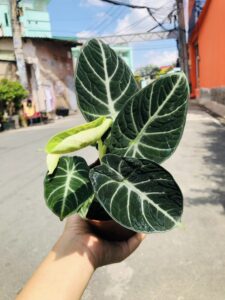Basic Information
Discover the Alocasia Ninja, an exquisite houseplant from Asia and Australia. With captivating large leaves, it’s perfect as an indoor tabletop plant. This guide helps you cultivate a thriving Alocasia Ninja and make it a vibrant addition to your indoor garden.



Light
Alocasia Ninja can adapt to varying light conditions. For best growth, it needs 6 hours of bright, indirect sunlight daily, avoiding direct sunlight that can burn its leaves. It prefers windows facing east or west. In low light, the growth rate may slow. Outside, it prefers dappled shade, similar to its natural habitat
Water
Watering the Alocasia Ninja plant requires a gentle and attentive approach. It is important to allow the soil to dry out slightly between each watering while maintaining a balance between moisture and drainage. Overwatering can be harmful and lead to root rot, which is a common issue faced by Alocasias. During the winter season, when the plant’s growth rate slows down, reducing the watering frequency is recommended. This allows the upper layer of soil to dry out more thoroughly. It is essential to ensure that any excess water drains away to prevent the roots from sitting in water.
Soil
Alocasia Ninja plants need a soil medium that strikes the right balance between drainage and nutrient retention. A blend rich in organic matter, such as coco-coir, peat moss, and shredded leaves, helps retain moisture while allowing excess water to drain away. A mix that’s too dense or retains too much water can lead to root rot, so consider using pre-mixed aroid soil or creating your blend that provides adequate aeration and drainage.
Temperature
Alocasia Ninja plants prefer warm environments typical of their subtropical origin. Room temperatures above 60°F (15°C) are suitable, and the plant should be protected from temperatures below 50°F (10°C). If moved outdoors in summer, they should be brought back indoors before the onset of colder temperatures. Avoid placing the plant near drafty windows and doors or near heating and cooling vents, as Alocasias are sensitive to sudden temperature changes.
Humidity
These plants thrive in high-humidity environments, ideally over 50%. In drier indoor climates, increasing humidity through misting, using a humidifier, or setting the plant on a water-filled pebble tray can be beneficial. However, ensure the plant is not kept in excessively damp conditions, which can encourage fungal diseases.
Fertilizer
During active growth in spring and summer, use a diluted complete liquid fertilizer or a slow-release option. Large-leafed varieties benefit from regular feedings. Reduce fertilizing to monthly in fall and winter. Over-fertilization can cause leaf burn, so adjust according to the plant’s response.
Growth Rate
In its peak spring and summer growth seasons, Alocasia Ninja can reach up to 2 feet in height. Its growth rate is dependent on care factors like light and fertilizer.
Pet Safety
Alocasia Ninja is toxic to pets. Its ingestion can cause irritation and swelling in the mouth and throat. Keep it out of reach of pets and children.
Grow in Semi-Hydro
- Alocasia plants excel in Semi-hydroponics (LECA/Pon) due to their natural inclination for root growth and humidity.
- Successfully transitioning Alocasia to Semi-hydroponics is enhanced with a Nutrient Stagnant Wicking (NSW) setup.
- Alocasia roots adapt seamlessly to the water in LECA/Pon, with quick resolution of any root hair issues in NSW setups.
- Fertilizer includes a nutrient mix concentration of approximately 800-1000ppm.
- These plants are versatile in different temperature and humidity settings, thriving in controlled environments.
- Long-term care involves maintaining a constant water reservoir and performing occasional system flushes for sustained growth.
Tips
- Rotate the plant regularly for sunlight exposure.
- Prune yellow or brown leaves to prevent pest infestation.
- Allow natural leaf shedding in fall and winter.
- Repot only when necessary, as the plant likes being slightly root-bound.
- Propagate by root division or cuttings for new plants.
The Alocasia Ninja is a captivating addition to any indoor plant collection. Proper care can bring a touch of subtropical elegance to your home. Remember, it requires consistent care regarding light, water, and humidity to thrive.
Happy planting! 🌱


